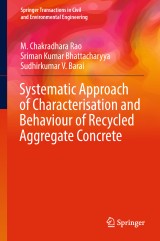Details

Systematic Approach of Characterisation and Behaviour of Recycled Aggregate Concrete
Springer Transactions in Civil and Environmental Engineering
|
96,29 € |
|
| Verlag: | Springer |
| Format: | |
| Veröffentl.: | 16.06.2018 |
| ISBN/EAN: | 9789811066863 |
| Sprache: | englisch |
Dieses eBook enthält ein Wasserzeichen.
Beschreibungen
This book focuses on the utilisation of construction waste material as coarse aggregate in making concrete. It discusses in detail the behaviour of recycled aggregate under impact load along with other structural applications, and explains the various quality-improvement techniques for recycled aggregate and recycled aggregate concrete (RAC). The first chapter describes the importance of recycling construction and demolition waste and the status quo of global construction and demolition waste recycling. The second chapter examines the recycled aggregate production methodology. Subsequent chapters address the physical and mechanical characteristics and different research findings, as well as the engineering properties of recycled aggregate concrete. Further, the interrelationships among the mechanical properties of recycled aggregate concrete are discussed. The book also explores long-term properties like shrinkage and creep, durability properties, and microstructural characterisation. It will serve as a valuable resource for researchers and professionals alike.
Introduction.- Production Process of Recycled Aggregate.- Properties of Recycled Aggregates.- Properties of Recycled Aggregate Concrete.- Long Term and Durability Properties.- Microstructure of Recycled Aggregate Concrete.- Structural Behaviour of RAC.- Quality Improvement Techniques.
<div>Chakradhara Rao M is an associate professor at the Civil Engineering Department at the Institute of Technology, Guru Ghasidas Vishwavidyalaya (a Central University), Bilaspur, Chhattisgarh, India. He holds a Ph.D. degree from the Indian Institute of Technology Kharagpur (IIT Kharagpur), an M.Tech. (Structural Eng.) from the National Institute of Technology (NIT), Surathkal, Karnataka and a B.Tech. (Civil Eng.) from Nagarjuna University, Guntur, Andhra Pradesh (A.P.). His research interests are sustainable construction materials and microstructure of concrete. He has published more than 20 papers in leading national/international journals and conferences.</div><div><br></div><div>Sriman K. Bhattacharyya is currently the Deputy Director of the Indian Institute of Technology Kharagpur (IIT Kharagpur). Formerly he was the Director of Council of Scientific & Industrial Research (CSIR)-Central Building Research Institute at Roorkee. He is a senior professor and Ex-head of Civil Engineering at IIT Kharagpur. His research interests include fluid–structure interactions, structural health monitoring, sustainability of materials and fibre-reinforced polymer (FRP)-Concrete composite systems. He is a fellow of the Indian National Academy of Engineering, Institution of Engineers (India) and Institution of Structural Engineering. He has travelled to various countries in connection with his research.</div><div><br></div><div>Sudhirkumar V. Barai holds B.E. (Civil) and M.E. (Civil) degrees with specialisation in Structural Engineering from Maharaja Sayajirao (M.S.) University of Baroda and a PhD (Eng.) from the Indian Institute of Science, Bangalore. He is a professor of Structural Engineering at the Department of Civil Engineering, Indian Institute of Technology Kharagpur, Kharagpur, India. His research interests include computational intelligence applications, structural health monitoring and concrete technology. He has published more than 200 papers in leading national/international journals and conferences. He is a fellow of the Association of Consulting Civil Engineers (India) and Institution of Engineers (India). He is also the co‐author (with Shailendra Kumar) of the book <i>Concrete Fracture Models and Applications</i>, which has recently been published by Springer.</div><div><br></div>
This book focuses on the utilisation of construction waste material as coarse aggregate in making concrete. It discusses in detail the behaviour of recycled aggregate under impact load along with other structural applications, and explains the various quality-improvement techniques for recycled aggregate and recycled aggregate concrete (RAC). The first chapter describes the importance of recycling construction and demolition waste and the status quo of global construction and demolition waste recycling. The second chapter examines the recycled aggregate production methodology. Subsequent chapters address the physical and mechanical characteristics and different research findings, as well as the engineering properties of recycled aggregate concrete. Further, the interrelationships among the mechanical properties of recycled aggregate concrete are discussed. The book also explores long-term properties like shrinkage and creep, durability properties, and microstructural characterisation. It will serve as a valuable resource for researchers and professionals alike.
Discusses systematically the characteristics of recycled aggregate obtained from different sources of construction waste Clarifies how recycled aggregate differs from natural aggregate Highlights the microstructure of recycled aggregate concrete Helps readers gain a better understanding of the behaviour of recycled aggregate concrete (RAC) under hardened state Explains the behaviour of RAC under impact load with colour pictures to enhance the readability Includes quality-improvement techniques for recycled aggregates to enable researchers to further enhance the quality of RAC
<div>Discusses systematically the characteristics of recycled aggregate obtained from different sources of construction waste</div><div>Clarifies how recycled aggregate differs from natural aggregate<br></div><div>Highlights the microstructure of recycled aggregate concrete<br></div><div>Helps readers gain a better understanding of the behaviour of recycled aggregate concrete (RAC) under hardened state<br></div><div>Explains the behaviour of RAC under impact load with colour pictures to enhance the readability<br></div><div>Includes quality-improvement techniques for recycled aggregates to enable researchers to further enhance the quality of RAC<br></div>
Diese Produkte könnten Sie auch interessieren:

Water Quality Hazards and Dispersion of Pollutants

von: Wlodzimierz Czernuszenko, Pawel Rowinski

149,79 €















